ISSN ONLINE(2320-9801) PRINT (2320-9798)
ISSN ONLINE(2320-9801) PRINT (2320-9798)
S.Nithya Kamatchi1, Dr. S.Suresh Kumar2
|
| Related article at Pubmed, Scholar Google |
Visit for more related articles at International Journal of Innovative Research in Computer and Communication Engineering
Algal bloom in an aquatic system, affects the inland ecosystem by producing toxins and it depletes the oxygen level in water, which causes death of organism. In this paper, a modified algal bloom recognition algorithm based on threshold segmentation is proposed for detecting and segmenting the algal blooms. The Modified ABR algorithm consists of three steps: 1) Image Preprocessing 2) Image classification using k means clustering and 3) Segmenting the algal bloom from the background water. In the first step the captured image is preprocessed, then in second step the image is classified as with algal bloom or without algal bloom and in the third step, image is segmented based on the clustered image. The algorithm was tested on series of images and the results shows that it can accurately segment the algal blooms from background. The proposed algorithm achieves 91.5% accuracy in segmenting the image.
KEYWORDS |
| Algal blooms monitoring, Image Classification, Modified Algal Bloom Recognition Algorithm, Image Segmentation, Threshold calculation. |
I. INTRODUCTION |
| In last few decades [14], algal bloom occurs frequently in most of the lakes. Algae are microscopic plants living in aquatic environments. They are vital primary producers for both marine and fresh-water ecosystems. Their growth is influenced by many different processes ranging from physical, chemical to biological and ecological processes and more. Algal blooms occur in freshwater as the result of an excess of nutrients, like phosphates which originates from fertilizers that are applied to land for agricultural or recreational purposes also from household cleaning products containing phosphorus [11]. Higher concentrations of phosphates in water systems causes increased growth of algae and plants. Algae tend to grow very quickly under high nutrient availability, but each algae is short-lived, and the result is a high concentration of dead organic matter which starts to decay. Presence of residual sodium carbonate acts as catalyst for the algae to bloom by providing dissolved carbon dioxide for enhanced photo synthesis in the presence of nutrients. Harmful algal blooms commonly occur as surface scums and “blooms” [14]. |
| The direct effects of HABs are the depletion of oxygen and blockage of sunlight that other organisms need for living. In addition, some algae release toxins that are dangerous to animals and even humans. HAB impacts can cause human illness and sometimes death from ingesting contaminated fish or shellfish, lead to mass mortalities of wild and farmed fish, cause alterations of marine food chains, as well as closure of coastal businesses. |
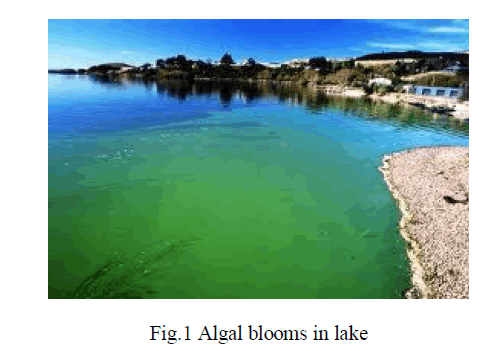 |
| The algae formation can be detected by several methods Remote sensing based methods, lab analysis method and based on sensors. Remote Sensing is one of the method to detect the algal bloom but this method is widely affected by weather condition and there is no short time scale monitoring and rapid response for algal blooms which makes the magnitude prediction difficult and in lab analysis methods. The sensor network based methods provide magnitude prediction and a real time detection of algal blooms. |
| This paper is organized as follows in section II the detailed literature review is done and the Algorithm used for algal bloom detection is designed, also the image segmentation process is discussed in Section III. Results of the above proposed system and comparison with other techniques are presented in Section IV. The Conclusion of this paper is provided in Section V. |
II. RELATED WORKS |
| A. Ensemble Methodology |
| The ensemble methods are widely explored in the fields of statistics, pattern recognition, and machine learning. The two strategic stages of this ensemble process are: 1) designing a set of classifiers that can generate diverse error distributions; 2) combining the decisions of these classifiers that can outperform all of the individual classifiers. The ensemble method [1] of the existing remote-sensing techniques for HAB detection with multistage learning, to overcome the limitations observed in the available techniques and to improve the overall performance. The ensemble methodology outperforms all of the individual members and gave a significant overall performance improvement up to 0.8632 Kappa accuracy. The performance is evaluated over tenfold cross validation average and compared against various ensemble methods and combination techniques. |
| B. Sensor Networks Based Methods |
| A data-driven soft sensor [15] for algal blooms monitoring, which estimates the magnitude of algal blooms using data collected by inexpensive water quality sensors as input. The modeling of the soft sensor consists of two steps: 1) magnitude calculation and 2) regression model training. In the first step, an active learning strategy to construct highaccuracy image classification model In the second step, Gaussian process to train the regression model that maps the multi-parameter water quality sensor data to the calculated magnitude of algal blooms and learn the parameters of the model automatically from the training data is used. |
| The number of salvage boats required for a specific algal blooms area is determined by the magnitude of the algal blooms. The total number of salvage boats is usually very limited, especially when the algal blooms with high magnitude are scattered all over the monitored water area. The predicted information can be used to monitor algal blooms in real-time and dispatch salvage boats. The results indicate this method can accurately predict the magnitude of algal blooms in 81% cases. |
| C. Multitemporal Analysis Method |
| MERIS images were used to detect algal bloom events in Lake Idro (Northern Italy) applying a semi-empirical algorithm Hydrological and weather parameters were examined at different temporal intervals (August-October, September-October and monthly from August to October) to investigate the regulating factors of bloom incidence. Rather low temperatures and the persistence of clouds seem to facilitate starting and maintenance of blooms [7]. |
| Here, understanding of the mechanisms regulating algal blooms is particularly intriguing as such phenomena are much less predictable in their timing and spatial dynamics. Furthermore, traditional sampling activities, according to the Water Framework directive are generally performed, for small lakes, on a single station, usually coinciding with the point of maximum lake depth that is chosen as representative of the average conditions of the entire water body. These sampling protocols do not have a high frequency that allows catching sudden and temporary phenomena (a few days) as blooms. Algal blooms can be triggered by littoral release of nutrients during the senescence period of the macrophytic biomass or by internal nutrient recycling. Overall, the complex phenomenon of onset of algal blooms requires further in-situ information to well explain the growing dynamics of phytoplankton. |
III. ALGAL BLOOM DETECTION SYSTEM |
| In this section, the modified algal bloom recognition algorithm for image segmentation is designed. The modified ABR algorithm includes Preprocessing for image enhancement, Clustering algorithm is used for grouping the same coloured pixel. Finally the threshold is calculated for image segmentation in detail. Figure 2 explain the overall process involved in modified ABR algorithm. |
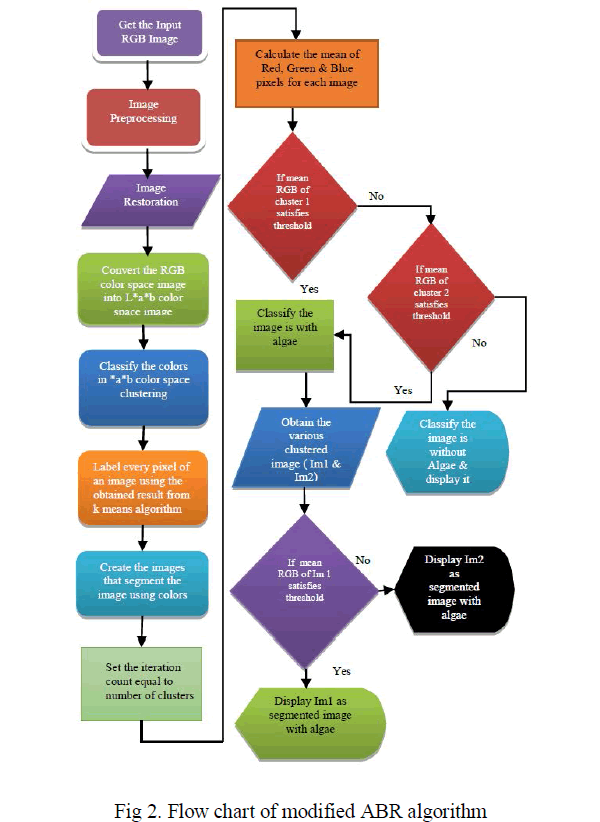 |
| A. Image Preprocessing |
| The image is captured through the camera sensor and the size of the image is calculated. The image has to be resized for further processing inorder to reduce the computation complexity. RGB image is separated into red, green and blue channels in the RGB colour space and the noise is removed using 2-D weiner filtering. The noise free images of Red, green and blue channels are restored. Converted to the grayscale image. To remove the Gaussian noise present in an image, Weiner2 filter is used. Wiener2 estimates the local mean and variance around each pixel. Using equation 2 and 3 mean and variance of the images are calculated respectively. |
 |
| Where ν2 is the noise variance. If the noise variance is not given, wiener2 uses the average of all the local estimated variances. |
| B. Image Classification |
| The image is classified with the help of k-means clustering algorithm. K-Means algorithm is an unsupervised clustering algorithm that classifies the input data points into multiple classes based on their inherent distance from each other. The algorithm assumes that the data features form a vector space and tries to find natural clustering in them. It aims to minimize the sum of squared distances between all points and the cluster centre. This procedure consists of the following steps, as described |
| Step1: Obtain the input RGB image for clustering |
| Step2: Convert the RGB colour space image into L*a*b colour space image |
| Step3: Classify the colours in *a*b colur space using kmeans clustering. |
| Step4: Label every pixel of an image using the obtained result from k means algorithm |
| Step5: Create the images that segment the image using colours |
| Step6: Set the iteration count equal to number of clusters, calculate the R,G,B mean for all the images |
| Step7: Based upon the threshold classify the image as with algal bloom or without algal bloom. |
| This is repeated for all the input images captured by the camera sensor. |
| C. Image Segmentation |
| After the image classification, if the image is classified as without algae then original image is shown. If it is classified as with algae then the image given for segmentation the image segmentation is done based on the threshold calculated. The red, green and blue pixels means of all the obtained clustered images are calculated and it is compared with the threshold. For each red, green and blue channels, the threshold is set and the respective values of each cluster is compared, the cluster which satisfies the threshold will be considered as the segmented image. |
| The magnitude of the algal bloom in an image is calculated as |
| Magnitude = Na / Np |
| Where Na is the number of pixels with algae and Np is the total number of pixels in the input image. |
IV. EVALUATION |
| A. Evaluation of Image Classification |
| The image classification using k-means clustering algorithm is tested with series of images. The mean value of red, green and blue channels are calculated for each clusters formed using k-means clustering. Each cluster is used for segmentation based on color. |
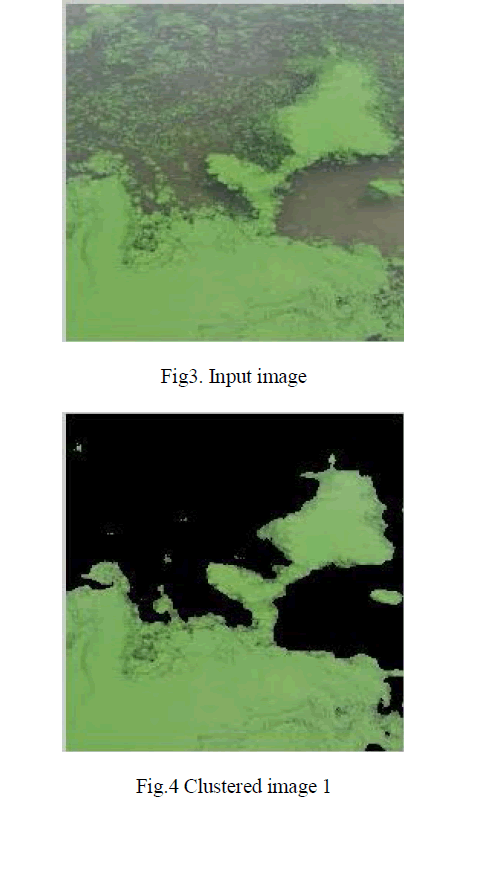 |
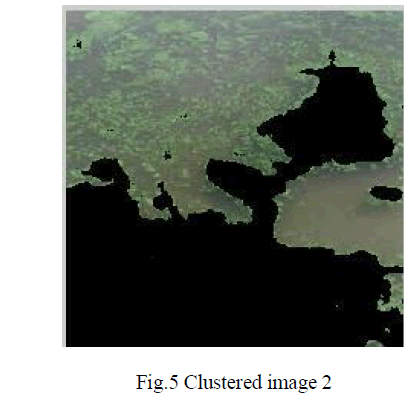 |
| Figure 3 is an input image captured by the camera sensor and the figure 4 and 5 are the clustered image formed by kmeans clustering algorithm. The threshold for red, green and blue values are fixed and the calculated mean values of each cluster is compared. Based upon the compared result each image is classified as with algal bloom or without algal bloom. If it is with algal bloom then it is segmented to find the magnitude of algal bloom. |
| B. Evaluation of Image Segmentation |
| The proposed algorithm is tested with series of images and the results are obtained. The images with algal blooms are segmented using the clusters formed. Each cluster has red, green and blue values. These are compared with threshold and the cluster with algae is displayed as segmented image. Figure 6 shows the input image of the lake and the segmented image using modified ABR algorithm is shown in figure 7. The result is compared with the OTSU method and the segmented image using OTSU method is shown in figure 8. From these figures we can see that modified ABR algorithm outperforms the OTSU method. The Segmentation was better when compared. The over- segmentation and under segmentation was reduced. |
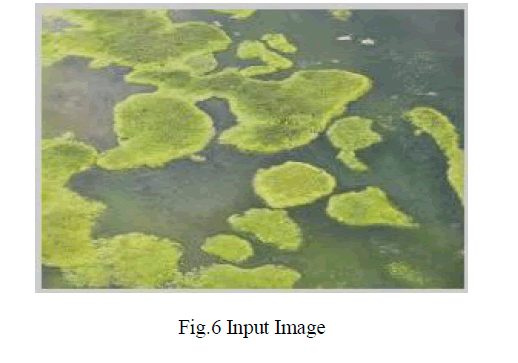 |
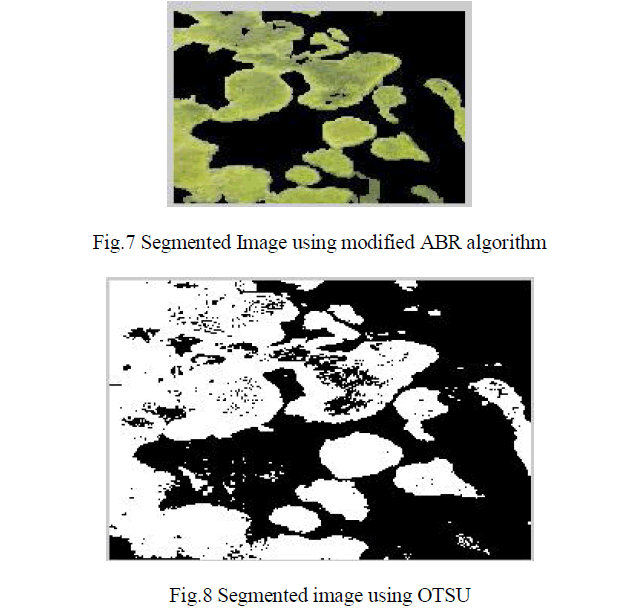 |
| The metrics considered for comparison are F, F’ [18] and E [18], where F measures the average squared colour error of the segments, penalizing over-segmentation by weighting proportional to the square root of the number of segments. It requires no user-defined parameters and is independent of the contents and type of image. F’ was proposed to improve F, because F was found to have a bias towards over-segmentation, which is the characteristic of producing many more regions than desired within a single real-world object. Since F favours segmentations with a large number of small regions, F’ extended F by penalizing segmentations that have many small regions of the same size. Q improves upon F’ by decreasing the bias towards both over-segmentation and under-segmentation (i.e. having too few regions to represent all the real-world objects in the image). E is an evaluation function based on information theory and the minimum description length principle (MDL). It uses region entropy as its measure of intra-region uniformity, which measures the entropy of pixel intensities within each region. It uses layout entropy, the entropy indicating which pixels belong to which regions, to penalize over-segmentation when the region entropy becomes small. There is no explicit metric for inter-region disparity, rather the inter-region disparity measure is implicit in the combination of region entropy and layout entropy, which counteract each other to provide a balance between over-segmentation and under segmentation. |
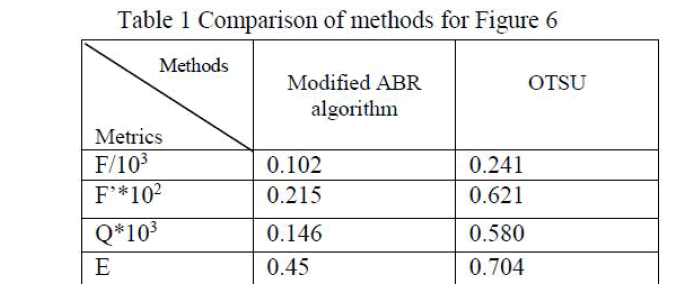 |
| The table 1 shows the comparison result of modified ABR algorithm and OTSU method. From the table we can infer that the modified ABR algorithm outperforms the OTSU in all parameters F, F’, Q and E. |
V. CONCLUSIONS |
| The Algal bloom detection using modified ABR algorithm is presented to overcome the existing systems drawbacks such as inaccurate magnitude calculation. The classification of image is done using kmeans clustering algorithm after preprocessing. The classification accuracy achieved was 95.6% The image which is classified as with algal bloom are segmented using the clusters formed by the k means algorithm and the threshold fixed. Segmentation using algal bloom recognition algorithm provides better result when compared with existing methods. The threshold based segmentation using the clustered image achieves 91.5 % accuracy. |
References |
|